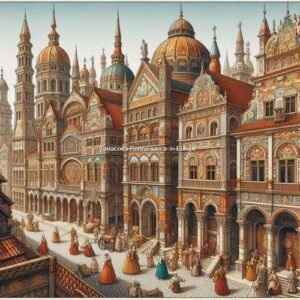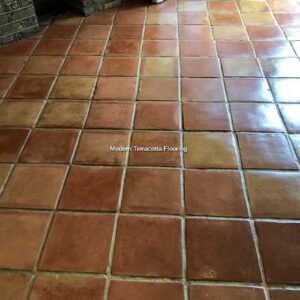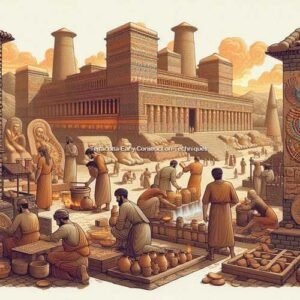Terracotta tiles have a long-standing presence in architecture and design, boasting a fascinating heritage encompassing various cultures and eras. These tiles have proven durable and adapted to changing trends, making them a popular choice for a wide range of uses. In this blog post, we will delve into the intriguing history of Terracotta and explore its widespread applications in modern design.
Ancient Origins: Discovering the Roots of Terracotta Tiles
Origins in Mesopotamia
Terracotta, a material used in construction for centuries, derives its name from the Italian phrase “baked earth.” Its origins can be traced back to the 3rd millennium BC in Mesopotamia, where it was commonly used to construct dwellings and temples. These tiles are perfect for such purposes due to their durability and natural beauty.
In ancient Mesopotamia, Terracotta served a dual purpose—it was not only functional but also carried deep symbolic meaning. The Assyrians and Babylonians extensively used Terracotta to construct palaces and religious sites. Its application served functional and ornamental purposes, highlighting its immense aesthetic and cultural value.
Construction Methods from the Past
The early utilisation of Terracotta in Mesopotamia established the foundation for its lasting impact. Builders in Mesopotamia were well aware of the material’s remarkable durability in the face of harsh weather conditions. Creating Terracotta involves shaping clay into desired forms and firing it at high temperatures for a hardened, durable product. This technique has remained virtually the same for millennia.
Evolution in Mediterranean Cultures: The Rise of Terracotta in Greece and Rome
Greece In Antiquity
Terracotta became widely used in the Mediterranean cultures of Greece and Rome, valued for its practicality and pleasing appearance. During ancient times in Greece, Terracotta was a popular material for constructing temples and public buildings. Greek architects excelled in working with Terracotta, creating elaborately shaped tiles arranged in intricate designs.
Advancements in Ancient Rome
The Romans made significant advancements in terracotta tile production techniques. They introduced moulds to ensure uniformity and experimented with various shapes, designs, intricate patterns, and pictorial motifs. Roman builders widely used Terracotta across multiple construction projects, including villas, public baths, and theatres. The development of interlocking roof tiles, known as “tegulae” and “imbrices,” was a remarkable Roman innovation.
Significance in Culture
Terracotta tiles in Roman architecture frequently showcased depictions of mythology and everyday life, reflecting the cultural values and artistic accomplishments of the era. The durability of Terracotta has ensured that many structures have stood the test of time, enabling modern observers to admire the skill of ancient builders.
 Terracotta Renaissance in Europe: Reviving an Ancient Craft
Terracotta Renaissance in Europe: Reviving an Ancient Craft
A New Beginning In The Renaissance
There was a renewed interest in Terracotta during the Renaissance era in Europe. Architects and designers have embraced this versatile material to bring a touch of sophistication to their projects. The tiles beautifully decorated the exteriors of magnificent structures, including grand buildings, churches, and palaces, demonstrating their capacity to elevate visual appeal while offering insulation and safeguarding.
Renowned Renaissance architects, such as Brunelleschi and Michelangelo, skillfully integrated Terracotta into their architectural masterpieces, appreciating its ability to create intricate and captivating exteriors.
Technical and Artistic Advancements
The Renaissance was a time of remarkable technology and art progress. Artisans perfected innovative glazing methods that infused terracotta tiles with rich hues and a lustrous sheen, elevating their allure.
Influence on European Architecture
The extensive use of Terracotta during the Renaissance greatly influenced European architecture, which persisted throughout the Baroque and Rococo eras.
Terracotta in Contemporary Design: Embracing Tradition in Modern Spaces
Modern Applications
Today, Terracotta continues to be popular in contemporary design. Their natural earthy tones and rustic charm lend warmth and character to indoor and outdoor spaces. In modern interior design, terracotta floors create a cosy and inviting atmosphere, often used in kitchens, living rooms, and bathrooms.
Sustainable and Eco-Friendly Choice
Terracotta floors are an eco-friendly option for sustainable building practices. Made from natural clay, they are biodegradable and have a low environmental impact. Their production process requires less energy than other building materials, and their durability means they have a long lifespan, reducing the need for frequent replacements.
Innovative Design Trends
Recent design trends have seen a resurgence in the use of Terracotta, with designers and architects exploring new ways to incorporate this timeless material into their projects. Terracotta tiles easily suit contemporary tastes, from geometric patterns and bold colours to minimalist and industrial aesthetics.
 Common Uses and Applications: Versatile and Functional Terracotta Tiles
Common Uses and Applications: Versatile and Functional Terracotta Tiles
Floor Covering
Terracotta can create captivating feature walls that enhance any room’s texture and visual appeal. They are highly effective in spaces that strive for a rustic or Mediterranean-inspired look.
Wall Covering
Terracotta can create stunning feature walls, adding texture and visual interest to any room. They work exceptionally well in spaces aiming for a rustic or Mediterranean-inspired aesthetic.
Roofing Material
Terracotta is a highly durable material, making it excellent for roofing. Terracotta offers exceptional protection from the elements while adding a unique charm to any building.
Stylish Embellishments
Terracotta tiles are famous for decorative accents in various architectural elements, including arches, columns, and cornices. Their adaptability enables designers to craft one-of-a-kind and visually captivating elements.
Landscape And Garden Use
Terracotta tiles are a great choice for enhancing the aesthetic appeal of garden paths, courtyards, and poolside areas. They bring a touch of natural beauty to outdoor spaces, and their earthy tones and textured surfaces effortlessly harmonise with the surrounding natural environment.
FAQs About Terracotta Tiles
What advantages do terracotta tiles offer in sustainable architecture?
Terracotta tiles are crafted with the utmost care, using natural clay, ensuring their eco-friendly nature and minimal environmental impact. With their exceptional durability and impressive lifespan, there is no need for frequent replacements.
What are some ways to improve the colour of terracotta tiles?
Consistent cleaning and effective sealing can help to enhance the colour. Utilising a colour-enhancing sealer can further accentuate the inherent shades.
Are there any current design trends for terracotta tiles?
Indeed, contemporary design incorporates geometric patterns and vibrant colours and seamlessly blends with minimalist and industrial aesthetics.
What are the recommended methods for installing terracotta tiles?
Proper surface preparation, selecting the appropriate adhesive, and allowing ample drying time are crucial for optimal results. Expert installation guarantees a secure and reliable placement.
Is it possible to utilise terracotta tiles for heated flooring systems?
Indeed, terracotta tiles are well-suited for heated flooring systems, ensuring effective heat distribution and a pleasant temperature.
Relevant Hyperlinked Sources
The post: Terracotta Tiles: A Fascinating Journey Through History and Time appeared first on TileCleaningSurrey.co.uk
The Article Terracotta Tiles: An Engaging Exploration of the Past and Present appeared first on https://fabritec.org
The Article Terracotta Tiles: An Engaging Exploration of the Past and Present Was Found On https://limitsofstrategy.com
The Article Terracotta Tiles: An Engaging Exploration of the Past and Present First Appeared ON
: https://ad4sc.com


Comments are closed